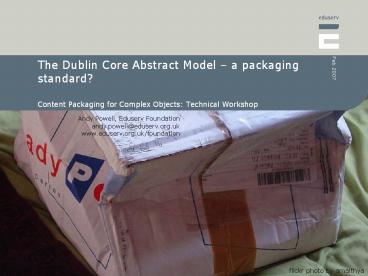The Dublin Core Abstract Model - PowerPoint PPT Presentation
Title:
The Dublin Core Abstract Model
Description:
... it was obvious that an element was really being used to ... Example 2 psuedo-XML descriptionSet description resourceURI=http://eprints.gla.ac.uk/503 ... – PowerPoint PPT presentation
Number of Views:16
Avg rating:3.0/5.0
Title: The Dublin Core Abstract Model
1
The Dublin Core Abstract Model a packaging
standard?
- Content Packaging for Complex Objects Technical
Workshop
flickr photo by amalthya
2
Why Dublin Core?
this workshop is about content packaging not
metadata!?
- well maybe
DC doesnt do content packaging does it?
DC is just 15 elements for describing Web pages
isnt it?
3
DC and content packaging
http//dublincore.org/documents/abstract-model/
- this talk is about the DCMI Abstract Model
- and its relationship to content packaging
- it is not intended as a tutorial
- but I appreciate that the DCMI Abstract Model is
new to many of you - I will therefore start by summarising the
background, context and main features of the DCAM - then Ill give some examples
- and finally try to draw some conclusions
4
DCMI Abstract Model background
- in the early days of Dublin Core there was no
explicit model associated with DC metadata
descriptions - there were implicit models and conventional
wisdom - largely flat in nature i.e. a set of metadata
elements describing a single thing (e.g. a Web
page) - and there were known problems
- like sometimes it was obvious that an element was
really being used to describe a second thing
(e.g. the author of a Web page)
5
DCMI Abstract Model background
- as the various DC syntaxes matured
- XHTML, XML and RDF/XML
- the underlying model became more important
- primarily as a mechanism for mapping between
syntaxes - and there have been a number of attempts at
applying the RDF model to DC
6
DCMI Abstract Model key features
- the DCAM (first published in 2005) attempts to
make explicit the model that underpins DC - the DCAM starts from the central notion of a
description set - a set of descriptions about a group of related
things (resources) - where each description is about a single
resource - and where each description is essentially made
up of property/value pair statements - descriptions sets are instantiated as records
(e.g. using XHTML, XML or RDF/XML) for the
purpose of exchanging information between
networked systems
7
Model summary
8
DCAM and relationships
- the DCAM is very open about the nature of the
relationships between the resources described in
a description set - whole / part (e.g. book / chapter / section /
page) - physical / digital (painting / digitised
painting) - object / human (document / author)
- conceptual / physical (work / item)
- or all of the above!
- the relationships between things is articulated
in an application model and captured using the
properties specified in an application profile
9
Example 1 Book application model
- here is a very simple application model
0..8
hasPart
Book
Chapter
10
Example 1 pseudo-XML description set
- ltdescriptionSetgt
- ltdescription resourceURIhttp//example.org/mybo
okgt - ltstatement propertyURIdctermshasPart
valueURIhttp//example.org/chapter1 /gt - ltstatement propertyURIdctermshasPart
valueURIhttp//example.org/chapter2 /gt - lt/descriptiongt
- ltdescription resourceURIhttp//example.org/chap
ter1gt - ltstatement propertyURIdctitlegt
- ltvalueStringgtChapter 1lt/valueStringgt
- lt/statementgt
- lt/descriptiongt
- ltdescription resourceURIhttp//example.org/chap
ter2gt - ltstatement propertyURIdctitlegt
- ltvalueStringgtChapter 2lt/valueStringgt
- lt/statementgt
- lt/descriptiongt
- lt/descriptionSetgt
11
Note 1 objects packaged by reference
- note that objects within the package (the
resources described within the description set)
are passed by reference - i.e. their URL is provided
- this is in common with other packaging standards
- passing by value (i.e. embedding the object
in-line) is theoretically possible using the DCAM
rich representation mechanism (but this is not
discussed further here)
12
Note 2 - ordering
- the DCAM has no built-in support for ordering
- the model is graph-based rather than being an
ordered tree - for applications requiring ordering, e.g. the
chapters in a book, it would therefore be
necessary to invent properties (e.g.
mysequenceNumber) to capture the ordering as
part of the description
13
Eprints application model
http//www.ariadne.ac.uk/issue50/allinson-et-al/
- here is a more complex application model
ScholarlyWork
14
Example 2 psuedo-XML
- ltdescriptionSetgt
- ltdescription resourceURIhttp//eprints.gla.ac.u
k/503/gt - ltstatement propertyURIdctitlegt
ltvalueStringgtAttempts to detect
retrotransposition and de novo deletion of Alus
and other dispersed repeats at specific loci in
the human genome lt/valueStringgt lt/statementgt - ltstatement propertyURIeprintisExpressedAs
valueRefexpression1 /gt - lt/descriptiongt
- ltdescription resourceIdexpression1 gt
- ltstatement propertyURIeprintisManifestedAs
valueRefpdfmanifestation /gt - lt/descriptiongt
- ltdescription resourceIdpdfmanifestation gt
- ltstatement propertyURIeprintisAvailableAs
- valueURIhttp//eprints.gla.ac.uk/503/01/Eu_
J._Hum_Gen.9(2)143_.pdf /gt - ltstatement propertyURIeprintisAvailableAs
- valueURIhttp//www.nature.com/ejhg/journal/
v9/n2/pdf/5200590a.pdf /gt - ltdescriptiongt
- lt! descriptions of the two copies here --gt
- lt/descriptionSetgt
15
Note 3 - Compound vs. complex objects
- note that the relationships between objects in
this example are more complex than hasPart or
isPartOf - because the model doesnt just deal with digital
objects - it may be worth drawing a distinction between
- compound objects (where objects have whole /
part type structural relationships) and - complex objects (where there are arbitrary
relationships between objects) ?? - most objects in digital libraries are complex
not just compound
16
Summary why DC?
- DC (and the DCAM) provides a simple packaging
framework - where objects within the package are typically
passed by reference - highly flexible and extensible relationship
framework between objects - supports multiple syntax encodings
- compatible with Semantic Web (which allows for
possibility of inferencing across complex objects
from unknown sources) - content packaging is largely about relationships
i.e. it is just metadata
17
Questions

